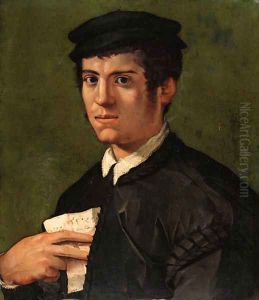Jacopo Di Giovanni Di Francesco, Called Jacone Paintings
Jacopo di Giovanni di Francesco, more famously known as Jacone, was an Italian painter born in 1493 in Florence, Italy. His nickname, 'Jacone', literally means 'Big Jack' in Italian, a testament perhaps to his personality or physical stature. Jacone was active during the High Renaissance, a period renowned for its artistic innovation and the flourishing of arts under the patronage of powerful families like the Medici in Florence. Despite being a lesser-known figure compared to the titans of the era such as Michelangelo, Leonardo da Vinci, and Raphael, Jacone contributed significantly to the art scene of his time, particularly in Florence and its surroundings.
Jacone's training and early career are not thoroughly documented, but it is believed that he was associated with, and possibly apprenticed under, Andrea del Sarto, one of the leading painters of the time. This connection would have placed him in the midst of the most progressive artistic circles of Florence. His works show a strong influence from del Sarto, especially in the use of color and the rendering of figures. However, Jacone also developed a distinct style, characterized by a robust and vigorous approach to painting, with a preference for dramatic expressions and compositions.
Much of Jacone's work consisted of religious subjects, a common theme for the era, including altarpieces and frescoes for churches. However, his output was not limited to religious art; he also produced portraits and mythological scenes, showcasing his versatility as an artist. Despite his talents, Jacone did not achieve the same level of fame as his contemporaries. This lack of recognition could be attributed to the limited documentation of his works and the overshadowing presence of his more famous peers.
Jacone's later years and his death in 1557 remain as enigmatic as much of his life. While some of his works have survived, many have been lost or remain attributed to him without absolute certainty. Today, Jacone is recognized as a talented artist of the High Renaissance whose contributions to the Italian art scene, although not as celebrated as those of his contemporaries, add depth and diversity to the understanding of this pivotal period in art history.
